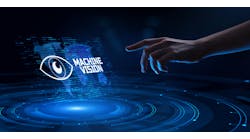There are many industrial applications where machine vision can provide a more robust and capable automated process than simple position and presence sensors, such as photo eyes. Unfortunately, these same machine-vision systems, smart sensors, for example, can affect machine performance and quality by not outputting accurate or repeatable data.
Fortunately, the technology available in off-the-shelf machine-vision sensors is well developed; it just must be properly implemented. To accomplish that, the machine-vision system must be professionally designed from the start, understood by engineers, technicians and operators, especially those not involved with its initial installation, and supportable well into the future. To do this, industry best practice requires creation of a vision-system design specification (VDS).
[pullquote]You cannot make a machine-vision system perform inspections it is not capable of performing, so quickly assembling a vision system, lens and light and mounting it to the machine and programming it isn’t best practice. Machine-vision hardware must be carefully specified, designed and tested—not only the camera itself, but the lens and lighting, as well, and how it is mounted to the machine. Resolutions, field of views and mounting positions of camera and light also play a big role.
The purpose of the vision-design specification is to specify how the vision-system hardware will be connected, configured and assembled to meet the inspection requirements. The VDS has several major sections that define a vision system from general to application-specific details.
General VDS sections include detail drawings of the parts being inspected and system interface to upper level systems, such as the PLC. A table of drawings and critical dimensions, features and requirements should be included.
The physical interface of the PLC to the cameras should also be detailed in a diagram with additional sections defining the data structure and communication interface, such as Ethernet. Timing diagrams are also helpful for understanding and system control and monitoring techniques, such as triggering, camera communication active and camera run mode.
Another general VDS section is the HMI, such as camera controls, images and graphical displays. The inspection-results data display should also be defined, including real-time and historical and data-trending. Include definition of how the inspection-results data and inspection images are saved. Future engineering analysis of the camera inspections will benefit from having clearly defined data and at least all reject images and a few good, “golden” part images for reference, saved.
With the general VDS sections complete, the next focus is application-specific—how each camera is configured and installed to complete the documented, required inspections. This includes a definition of the inspections, mechanical-layout diagrams, sample images, camera specifications, lens and lighting specifications and definition of the field of view (FOV)—each a section of the VDS.
[javascriptSnippet ]
The inspections should be detailed so all can understand what dimensions, features and orientations are checked with expected results and reject definitions. Then a mechanical-layout diagram or two is required to show the camera, lens configuration, including spacers and adapters, and light. The layout diagram should also detail the position of the inspected part relative to the face of the camera lens and light. Include dimensions and part numbers. Sample images of the inspection acquired using the defined layout must also be included for reference.
Additional application detail sections include specification tables for the camera, lens and light. Include camera part number, type of image, such as area or line scan, resolution, orientation and cabling. Lens part number plus spacers and adapters must be listed along with the FOV, working distance and depth of field. Fixed-focus or adjustable-focus details should also be listed, as well as focal and f-stop settings. Images of the lens settings are helpful and should be documented for future reference. Finally, include a lighting specification table including part number, color, location and distance to part, as well as power supply and triggering such as strobe or constant on.
A field-of-view diagram section must document the height and width of the acquired image relative to the inspected part. Include both pixel and engineering unit dimensions. This diagram can be an actual image or a graphical representation of the FOV.
Some final sections of the VDS, often for each, include calibration, camera checks and reject characteristics. Calibration may need to be carefully detailed for measurement applications. However, telecentric lenses often do not need calibration after their initial setup, so it is important to carefully detail these requirements.
Camera checks, such as exposure and focus, should also be defined. This is important information to know over the lifetime of the application and can show if inspections are changing. Test gauges, golden parts and/or challenge parts should also be defined and detailed to prove the vision system is working as expected over time and enable recalibration and adjustments if not. And be sure to include example reject images and details of the inspection tools used to find them.
Clearly defining vision system hardware, mechanical configuration and the application-specific requirements in a vision-design specification is industry best practice. Be sure to create one, implement the vision system as designed and then clean up the VDS after final testing to ensure accurate, usable information now and in the future.






